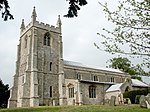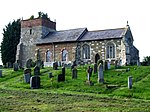Batemans Brewery
1874 establishments in EnglandBreweries in EnglandBritish companies established in 1874Companies based in LincolnshireFood and drink companies established in 1874 ... and 3 more
Lincolnshire cuisineUse British English from January 2019Wainfleet All Saints

Batemans Brewery (George Bateman & Son Ltd) is an English brewery based at Salem Bridge Brewery in Wainfleet, Lincolnshire, and founded in 1874. The company owns 69 public houses, with 23 situated in Boston alone. The brewery focuses on cask conditioned ales, their best known being XB and XXXB. Their slogan is "Good Honest Ales".
Excerpt from the Wikipedia article Batemans Brewery (License: CC BY-SA 3.0, Authors, Images).Batemans Brewery
Vicarage Lane, East Lindsey Wainfleet St Mary
Geographical coordinates (GPS) Address Nearby Places Show on map
Geographical coordinates (GPS)
| Latitude | Longitude |
|---|---|
| N 53.103 ° | E 0.23 ° |
Address
Vicarage Lane
Vicarage Lane
PE24 4JJ East Lindsey, Wainfleet St Mary
England, United Kingdom
Open on Google Maps









